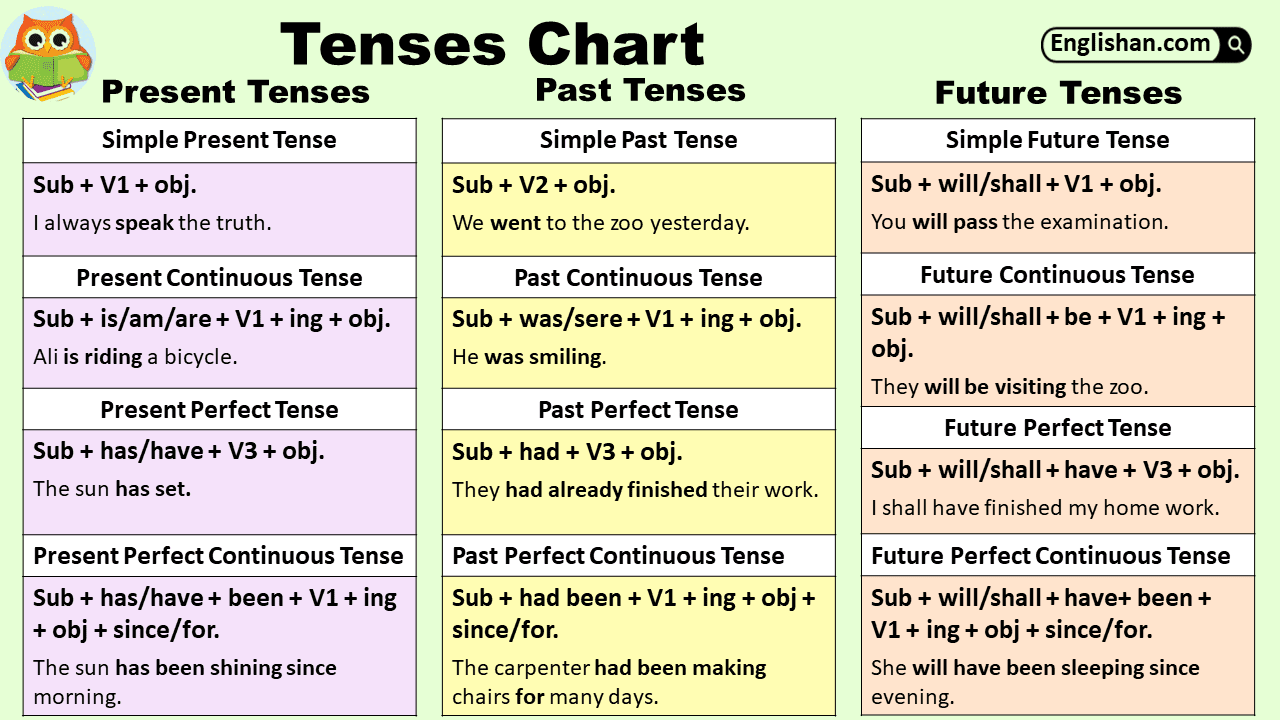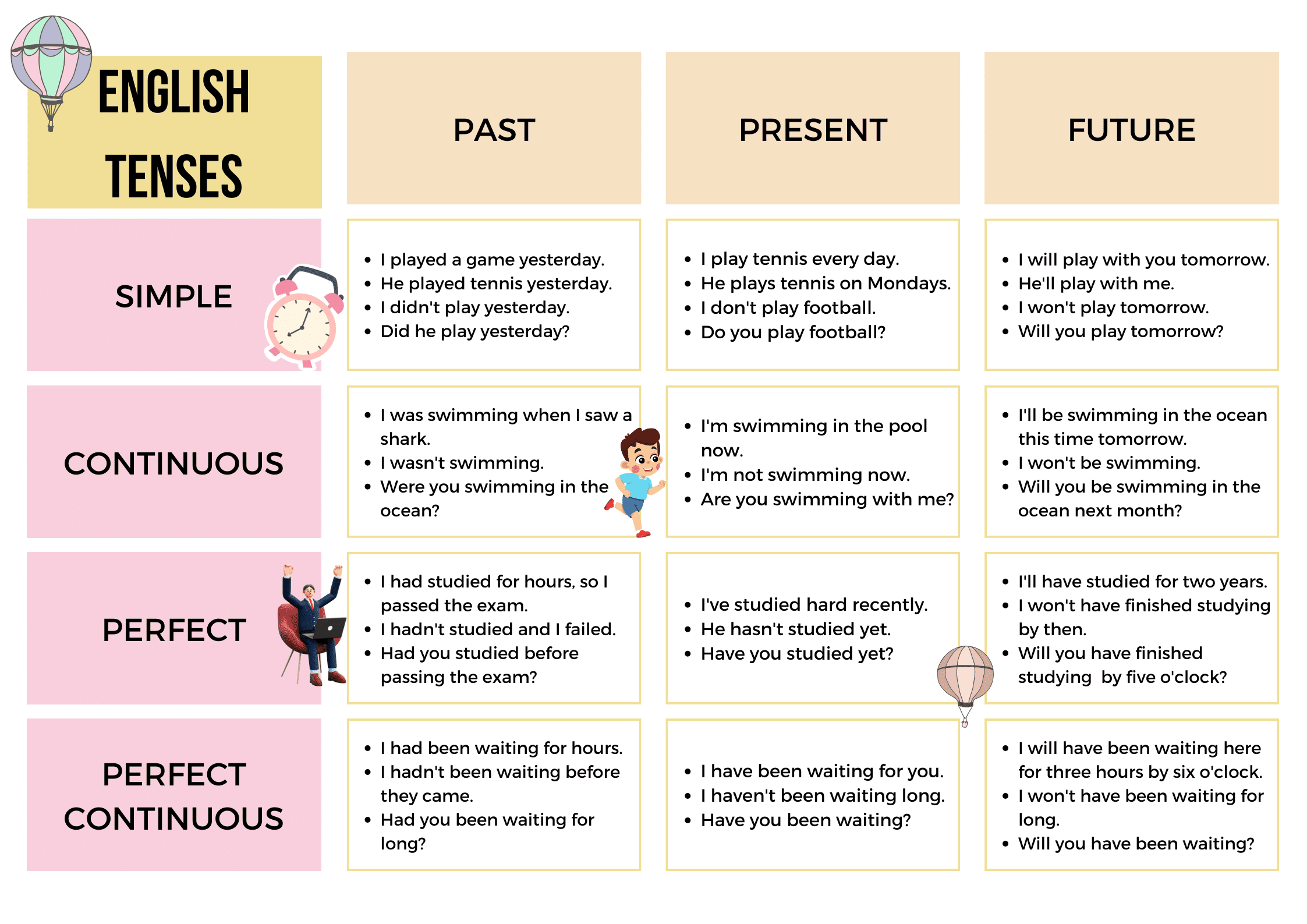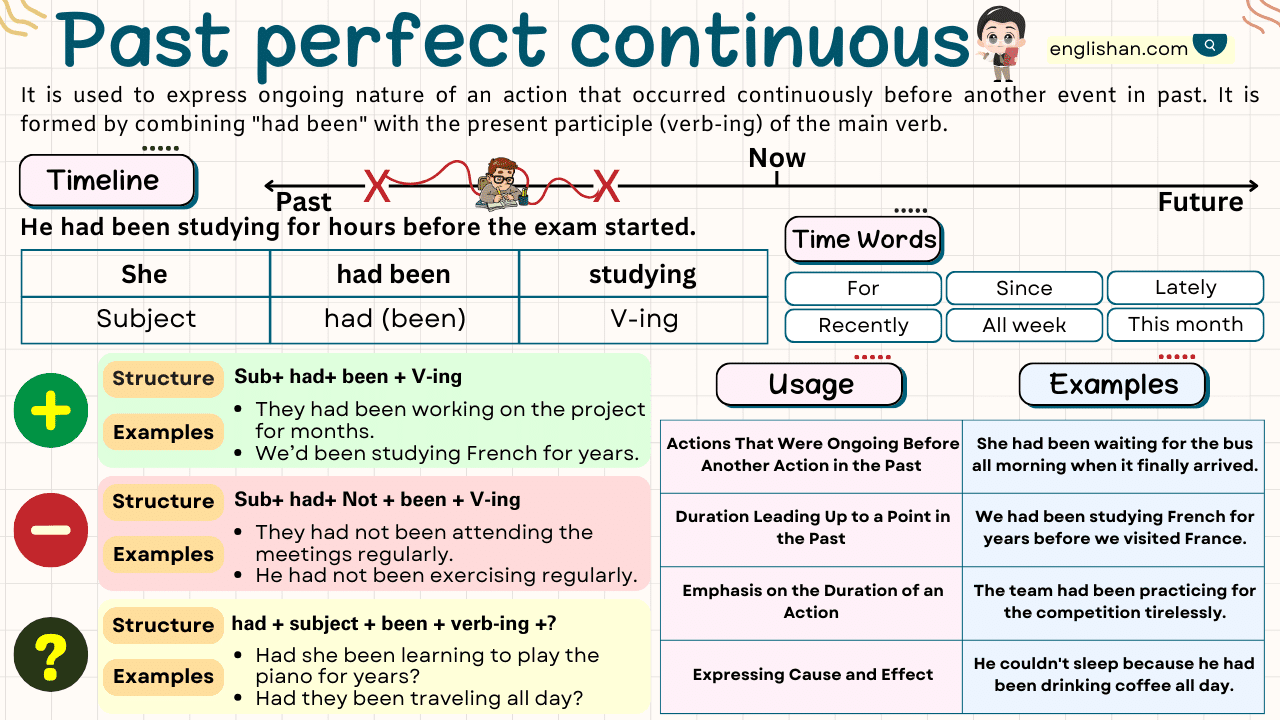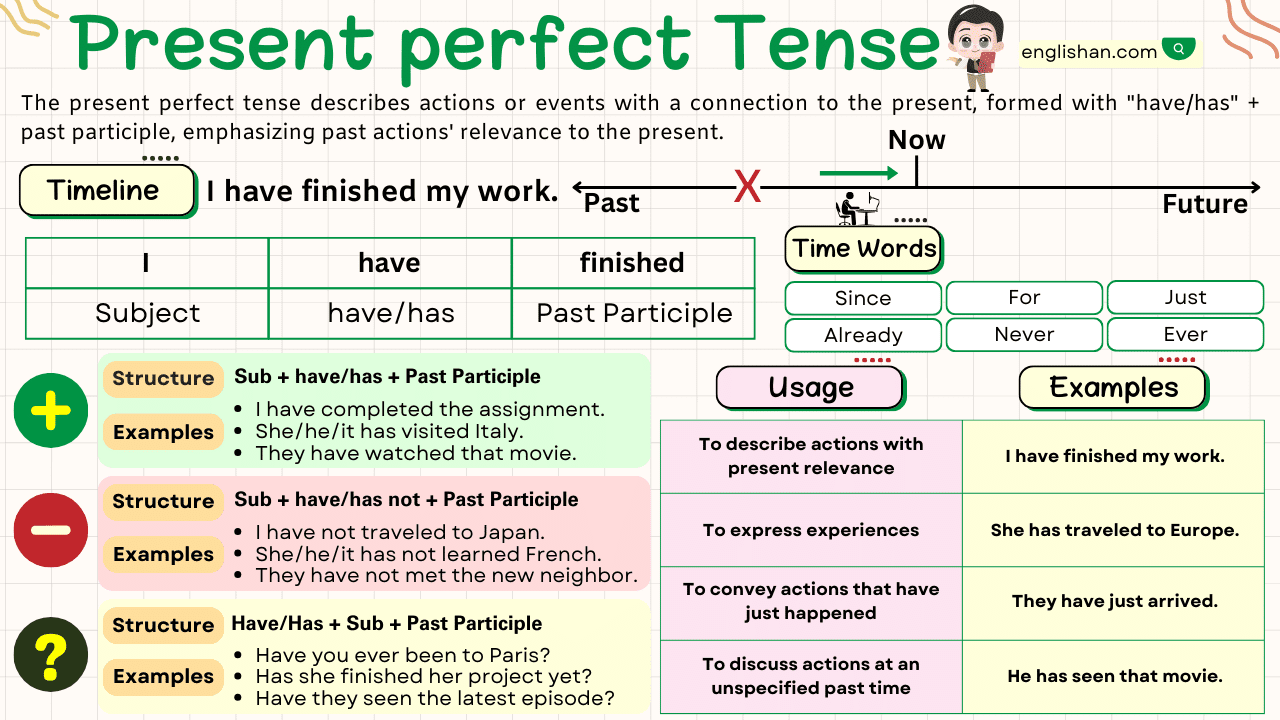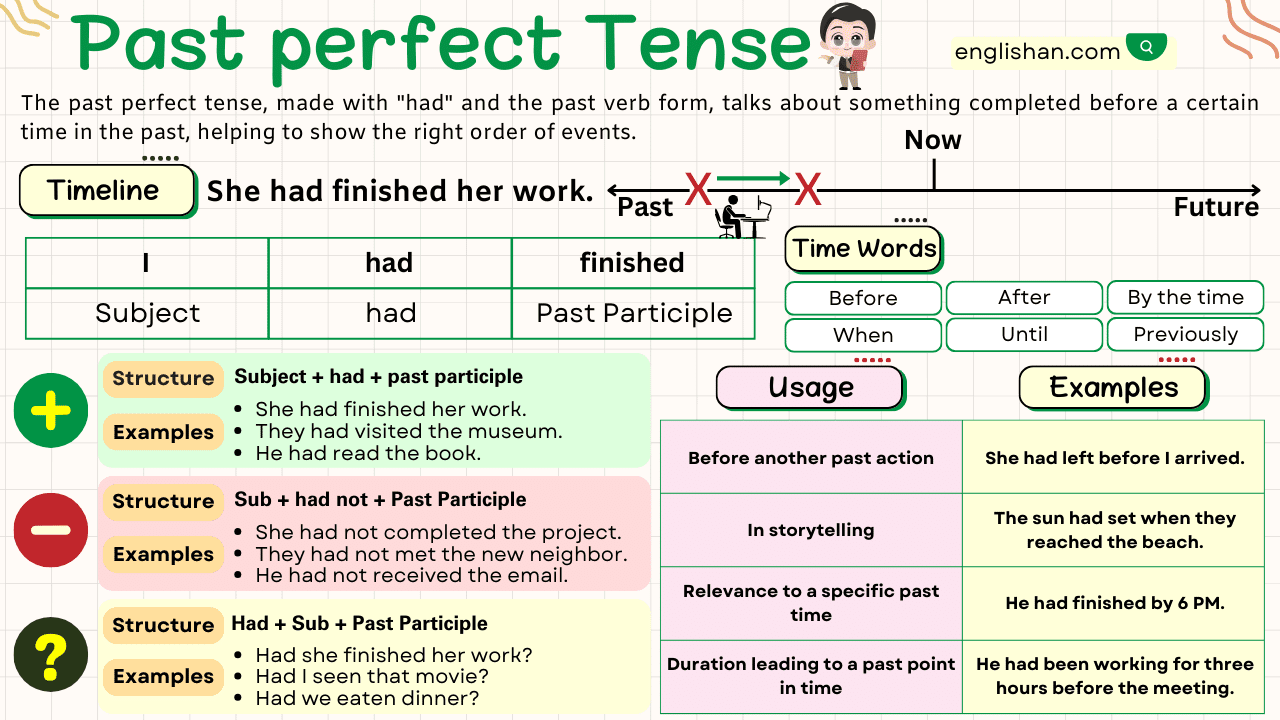Contents
A tenses chart is a valuable visual tool that helps learners understand how verb tenses function in English. It outlines the structures, rules, and common uses of various tenses in English grammar. This chart serves as a reference guide for anyone learning how to express actions across different time frames—whether past, present, or future.
In this article, we will explore a tenses chart along with example sentences and formulas, helping you understand how to construct sentences in different tenses.
Types of Tenses in English
There are three primary types of tenses:
- Present Tense
- Past Tense
- Future Tense
Each of these tenses can be divided further into four subforms:
- Simple
- Perfect
- Continuous
- Perfect Continuous
These subforms allow speakers to convey nuances of time, such as ongoing actions, completed actions, or actions that have been happening for a duration.
12 Tenses Chart in English
Here’s a simple breakdown of the various tenses in English along with their forms:
- Present Tense
- Simple Present Tense
- Present Perfect Tense
- Present Continuous Tense
- Present Perfect Continuous Tense
- Past Tense
- Simple Past Tense
- Past Perfect Tense
- Past Continuous Tense
- Past Perfect Continuous Tense
- Future Tense
- Simple Future Tense
- Future Perfect Tense
- Future Continuous Tense
- Future Perfect Continuous Tense
Before we dive into the structures of the tenses, let’s understand the abbreviations and short forms of the words we are going to use in the structures.
Explanation of Short Words Used in Tenses
Throughout this article, you’ll see several short words that represent common grammatical terms:
- Sub: This stands for Subject, which refers to the person or thing performing the action in a sentence (e.g., I, She, They).
- V1: The base form of a verb (e.g., play, run, eat).
- V2: The past form of a verb (e.g., played, ran, ate).
- V3: The past participle form of a verb (e.g., played, run, eaten).
- Obj: This stands for Object, the noun or pronoun that receives the action of the verb in a sentence (e.g., book, ball).
- Helping Verb: Also known as an auxiliary verb, these verbs (e.g., have, has, will, shall) help the main verb to form different tenses.
Chart of Formulas of Tenses
Let’s take a look and learn tenses chart with formulas of tenses, which outlines how to form sentences in different tenses. This chart will help you understand the structure of verbs across past, present, and future actions, making sentence construction easier.
Simple Present Tense
- Affirmative: Sub + Verb1 + Obj.
- Negative: Sub + do/does not + Verb1 + Obj.
- Interrogative: Do/Does + Sub + Verb1 + Obj?
- Double Interrogative: Wh-word + do/does + Sub + Verb1 + Obj?
Present Continuous Tense
- Affirmative: Sub + am/is/are + Verb1 + -ing + Obj.
- Negative: Sub + am/is/are + not + Verb1 + -ing + Obj.
- Interrogative: Am/Is/Are + Sub + Verb1 + -ing + Obj?
- Double Interrogative: Wh-word + am/is/are + Sub + Verb1 + -ing + Obj?
Present Perfect Tense
- Affirmative: Sub + has/have + Verb3 + Obj.
- Negative: Sub + has/have + not + Verb3 + Obj.
- Interrogative: Has/Have + Sub + Verb3 + Obj?
- Double Interrogative: Wh-word + has/have + Sub + Verb3 + Obj?
Present Perfect Continuous Tense
- Affirmative: Sub + has/have been + Verb1 + -ing + Obj + since/for.
- Negative: Sub + has/have + not + been + Verb1 + -ing + Obj + since/for.
- Interrogative: Has/Have + Sub + been + Verb1 + -ing + Obj + since/for?
- Double Interrogative: Wh-word + has/have + Sub + been + Verb1 + -ing + Obj + since/for?
Simple Past Tense
- Affirmative: Sub + Verb2 + Obj.
- Negative: Sub + did not + Verb1 + Obj.
- Interrogative: Did + Sub + Verb1 + Obj?
- Double Interrogative: Wh-word + did + Sub + Verb1 + Obj?
Past Continuous Tense
- Affirmative: Sub + was/were + Verb1 + -ing + Obj.
- Negative: Sub + was/were + not + Verb1 + -ing + Obj.
- Interrogative: Was/Were + Sub + Verb1 + -ing + Obj?
- Double Interrogative: Wh-word + was/were + Sub + Verb1 + -ing + Obj?
Past Perfect Tense
- Affirmative: Sub + had + Verb3 + Obj.
- Negative: Sub + had + not + Verb3 + Obj.
- Interrogative: Had + Sub + Verb3 + Obj?
- Double Interrogative: Wh-word + had + Sub + Verb3 + Obj?
Past Perfect Continuous Tense
- Affirmative: Sub + had been + Verb1 + -ing + Obj + since/for.
- Negative: Sub + had + not + been + Verb1 + -ing + Obj + since/for.
- Interrogative: Had + Sub + been + Verb1 + -ing + Obj + since/for?
- Double Interrogative: Wh-word + had + Sub + been + Verb1 + -ing + Obj + since/for?
Simple Future Tense
- Affirmative: Sub + will/shall + Verb1 + Obj.
- Negative: Sub + will/shall + not + Verb1 + Obj.
- Interrogative: Will/Shall + Sub + Verb1 + Obj?
- Double Interrogative: Wh-word + will/shall + Sub + Verb1 + Obj?
Future Continuous Tense
- Affirmative: Sub + will/shall be + Verb1 + -ing + Obj.
- Negative: Sub + will/shall + not + be + Verb1 + -ing + Obj.
- Interrogative: Will/Shall + Sub + be + Verb1 + -ing + Obj?
- Double Interrogative: Wh-word + will/shall + Sub + be + Verb1 + -ing + Obj?
Future Perfect Tense
- Affirmative: Sub + will/shall have + Verb3 + Obj.
- Negative: Sub + will/shall + not + have + Verb3 + Obj.
- Interrogative: Will/Shall + Sub + have + Verb3 + Obj?
- Double Interrogative: Wh-word + will/shall + Sub + have + Verb3 + Obj?
Future Perfect Continuous Tense
- Affirmative: Sub + will/shall have been + Verb1 + -ing + Obj + since/for.
- Negative: Sub + will/shall + not + have been + Verb1 + -ing + Obj + since/for.
- Interrogative: Will/Shall + Sub + have been + Verb1 + -ing + Obj + since/for?
- Double Interrogative: Wh-word + will/shall + Sub + have been + Verb1 + -ing + Obj + since/for?
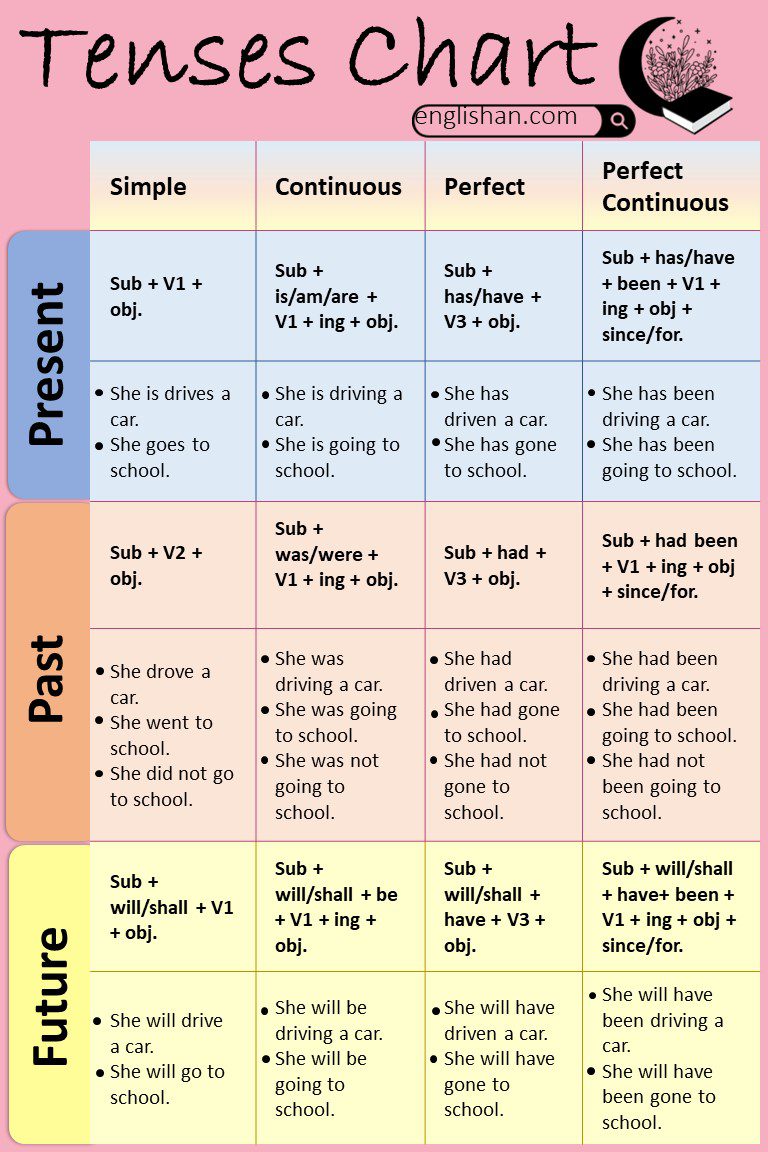
Examples Sentences Chart of Tenses
Let’s learn tenses through a tenses chart with examples of different tenses. This will help you understand how verbs change to express actions in the past, present, and future.
Simple Present Tense
- Affirmative:
She plays tennis every weekend.
They visit the park regularly. - Negative:
She does not play tennis on weekdays.
They do not go to the park often. - Interrogative:
Does she play tennis on weekends?
Do they visit the park every day? - Double Interrogative:
Why does she play tennis every weekend?
When do they visit the park?
Present Continuous Tense
- Affirmative:
He is reading a book now.
They are working on the project. - Negative:
He is not reading a book now.
They are not working on the project. - Interrogative:
Is he reading a book now?
Are they working on the project? - Double Interrogative:
Why is he reading a book now?
What are they working on?
Present Perfect Tense
- Affirmative:
She has finished her homework.
They have visited Paris. - Negative:
She has not finished her homework.
They have not visited Paris. - Interrogative:
Has she finished her homework?
Have they visited Paris? - Double Interrogative:
Why has she finished her homework early?
Where have they visited recently?
Present Perfect Continuous Tense
- Affirmative:
I have been studying for two hours.
They have been playing football since morning. - Negative:
I have not been studying for two hours.
They have not been playing football since morning. - Interrogative:
Have you been studying for two hours?
Have they been playing football since morning? - Double Interrogative:
How long have you been studying?
Why have they been playing football since morning?
Simple Past Tense
- Affirmative:
She wrote a letter yesterday.
They visited the museum last week. - Negative:
She did not write a letter yesterday.
They did not visit the museum last week. - Interrogative:
Did she write a letter yesterday?
Did they visit the museum last week? - Double Interrogative:
When did she write the letter?
Why did they visit the museum?
Past Continuous Tense
- Affirmative:
He was cooking dinner last night.
They were watching TV when I called. - Negative:
He was not cooking dinner last night.
They were not watching TV when I called. - Interrogative:
Was he cooking dinner last night?
Were they watching TV when you called? - Double Interrogative:
What was he cooking last night?
Why were they watching TV when you called?
Past Perfect Tense
- Affirmative:
She had completed her task before the meeting.
They had left by the time we arrived. - Negative:
She had not completed her task before the meeting.
They had not left when we arrived. - Interrogative:
Had she completed her task before the meeting?
Had they left before you arrived? - Double Interrogative:
When had she completed her task?
Why had they left before you arrived?
Past Perfect Continuous Tense
- Affirmative:
He had been working there for five years before he quit.
They had been waiting for an hour before the bus arrived. - Negative:
He had not been working there for five years.
They had not been waiting for an hour. - Interrogative:
Had he been working there for five years?
Had they been waiting for an hour? - Double Interrogative:
How long had he been working there?
Why had they been waiting for an hour?
Simple Future Tense
- Affirmative:
I will visit you tomorrow.
They will attend the concert next week. - Negative:
I will not visit you tomorrow.
They will not attend the concert next week. - Interrogative:
Will you visit me tomorrow?
Will they attend the concert next week? - Double Interrogative:
Why will you visit me tomorrow?
When will they attend the concert?
Future Continuous Tense
- Affirmative:
She will be working at 6 PM.
They will be traveling to Japan next month. - Negative:
She will not be working at 6 PM.
They will not be traveling to Japan next month. - Interrogative:
Will she be working at 6 PM?
Will they be traveling to Japan next month? - Double Interrogative:
Where will she be working at 6 PM?
Why will they be traveling to Japan next month?
Future Perfect Tense
- Affirmative:
By tomorrow, I will have completed the project.
She will have graduated by next year. - Negative:
By tomorrow, I will not have completed the project.
She will not have graduated by next year. - Interrogative:
Will you have completed the project by tomorrow?
Will she have graduated by next year? - Double Interrogative:
When will you have completed the project?
Why will she have graduated by next year?
Future Perfect Continuous Tense
- Affirmative:
By next month, I will have been working here for two years.
They will have been traveling for a week by the time they return. - Negative:
By next month, I will not have been working here for two years.
They will not have been traveling for a week by the time they return. - Interrogative:
Will you have been working here for two years by next month?
Will they have been traveling for a week by the time they return? - Double Interrogative:
How long will you have been working here by next month?
How long will they have been traveling by the time they return?
FAQs
The 12 tenses in English show different times and actions. Here’s a quick table:
Present Simple – I eat
Present Continuous – I am eating
Present Perfect – I have eaten
Present Perfect Continuous – I have been eating
Past Simple – I ate
Past Continuous – I was eating
Past Perfect – I had eaten
Past Perfect Continuous – I had been eating
Future Simple – I will eat
Future Continuous – I will be eating
Future Perfect – I will have eaten
Future Perfect Continuous – I will have been eating
In grammar, tense shows the time of an action or state. It tells whether something happens in the past, present, or future.
For example, “I walk” (present), “I walked” (past), and “I will walk” (future). Tenses help readers know when something occurs.
To explain tenses to kids:
What Are Tenses?
Tenses tell us when something happens:
1. Past: Already happened (e.g., I ate).
2. Present: Happening now (e.g., I eat).
3. Future: Will happen later (e.g., I will eat).
4 Types of Tenses
1. Simple: Just the action (e.g., I eat).
2. Continuous: Ongoing action (e.g., I am eating).
3. Perfect: Finished action (e.g., I have eaten).
4. Perfect Continuous: Started earlier, still happening (e.g., I have been eating).
How to Teach It?
1. Use stories: Show actions in past, present, and future.
2. Ask everyday questions: “What did you do yesterday?”
3. Draw a timeline to show past, present, and future.
4. Play games: Sentence fill-in or acting out verbs.
Read More
- Present Indefinite Tense Worksheets
- Present Continuous Tense Worksheets
- Present Perfect Tense Worksheets
- Present Perfect Continuous Worksheets
- Past Continuous Tense Worksheets
- Worksheet Tenses
- Choose the Correct Direct Narration
